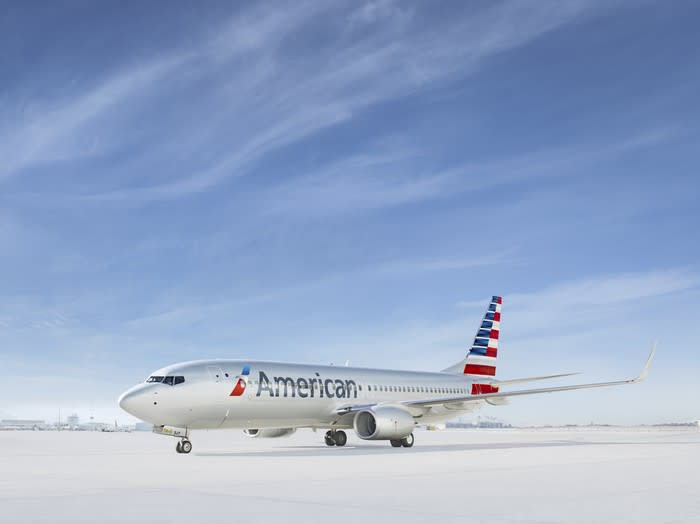American Airlines Earnings: Plenty of Problems, but Signs of Progress
American Airlines' (NASDAQ: AAL) second-quarter earnings report contained mixed news for shareholders. On the bright side, the airline giant's adjusted earnings per share came in slightly ahead of analysts' expectations last quarter. The company also stabilized its adjusted pre-tax margin. That said, American Airlines is lagging well behind its peers in terms of profitability, and many analysts and investors found its outlook for the rest of the year disappointing.
Indeed, looking just at the hard numbers, American Airlines seems to be in pretty bad shape. However, it is facing numerous short-term headwinds right now, and some of its main profit improvement initiatives haven't fully kicked in yet. The recent earnings report included some promising signs that American is close to turning the corner.
A modest earnings beat
Earlier this month, American Airlines raised its unit revenue forecast for the second quarter, saying that revenue per available seat mile (RASM) would increase by 3% to 4% year over year. Last week, the company confirmed that RASM wound up right in the middle of that updated guidance range, rising 3.5%.
Meanwhile, adjusted nonfuel unit costs rose 4.8% and American's average fuel price fell 4.4% to $2.14 per gallon. Both of those results fell within the company's updated guidance range.
Compared to the company's initial outlook for the second quarter (published back in April), unit revenue came in ahead of expectations while costs were roughly in line. The net result was that American Airlines' adjusted pre-tax margin reached 9%, up from 8.7% a year earlier and at the high end of the 7% to 9% range provided in April. Adjusted EPS reached $1.82, up 9.6% from $1.66 in the prior-year period.

American Airlines' profit increased modestly last quarter. Image source: American Airlines.
The guidance was mediocre
Looking ahead, American Airlines expects RASM growth between 1% and 3% in Q3. Fuel prices are still down year over year, offset by rising nonfuel unit costs -- driven in part by the grounding of the Boeing (NYSE: BA) 737 MAX. As a result, the carrier expects to post an adjusted pre-tax margin between 5.5% and 7.5% this quarter.
At the midpoint of the range, this would represent an improvement over American's 6% adjusted pre-tax margin in the third quarter of 2018. However, it's less than half of Delta Air Lines' (NYSE: DAL) projected profit margin for the current quarter. (American Airlines also trailed Delta's Q2 adjusted pre-tax margin of 16% by a country mile.)
American Airlines did raise the low end of its full-year EPS forecast by $0.50, yielding a new guidance range of $4.50 to $6.00. However, that still compares unfavorably to American's initial outlook for the year, when it called for EPS between $5.50 and $7.50.
There have been unusual disruptions this year
American Airlines' 2019 earnings results certainly look bad compared to how Delta is doing. However, American is facing a lot more headwinds than its rival right now.
Chief among those disruptions is the grounding of the Boeing 737 MAX. In conjunction with the earnings report, American raised its estimate of the full-year cost of the grounding from $350 million to $400 million. That includes $175 million in lost pre-tax profit last quarter -- reducing the company's pre-tax margin by almost 1.5 percentage points -- and $125 million in lost pre-tax profit for the third quarter.
American Airlines is also in the middle of a major labor dispute with its mechanics, which has dramatically hurt its reliability in recent months. This has increased its costs and may have driven some customers away. Additionally, to avoid exacerbating the impact of the Boeing 737 MAX grounding and the labor dispute, American Airlines delayed projects to add seats to its existing Boeing 737-800 and Airbus A321 jets, retrofits that would have reduced American's unit costs.

American Airlines has delayed plans to add seats to some of its older planes. Image source: American Airlines.
Finally, American Airlines has made changes to its loyalty program to make more redemption opportunities available. That's reducing its unit revenue growth by about 0.8 percentage points this year -- and negatively impacting its pre-tax margin by a similar amount.
The underlying trends are promising
On the bright side for investors, most of these headwinds should fade over the next few quarters. American Airlines is optimistic about being able to put its 737 MAX fleet back into service in November. (Boeing is also likely to compensate American for the costs of the grounding.) The airline will lap its loyalty program changes at the end of 2019, ending that headwind. And it expects to resume its 737-800 and A321 retrofit programs next year.
It's harder to be sure about when American Airlines will resolve the dispute with its mechanics, but it is close to getting a permanent court order that should reduce the impact on its operations. A similar scenario played out at Southwest Airlines earlier this year, and the two sides reached a new contract agreement soon after the airline took its mechanics' union to court.
Additionally, American Airlines added more than 100 daily flights to its schedule at Dallas-Fort Worth International Airport last quarter. Those extra flights at its largest (and highly profitable) hub are already producing above-average margins. The margin improvement from this expansion should increase as the new flights mature over the next several quarters. Similar growth plans at two other highly profitable hubs will add to American's unit revenue momentum over the next couple of years.
American Airlines is already delivering solid unit revenue growth and modest margin gains despite all of the issues it has encountered this year. With conditions likely to improve over the next few quarters, there's a good chance that profit growth will accelerate in 2020.
Adam Levine-Weinberg owns shares of Delta Air Lines and Southwest Airlines and is long January 2020 $20 calls on American Airlines Group. The Motley Fool owns shares of and recommends Delta Air Lines and Southwest Airlines. The Motley Fool has a disclosure policy.
This article was originally published on Fool.com

 Yahoo Finance
Yahoo Finance 